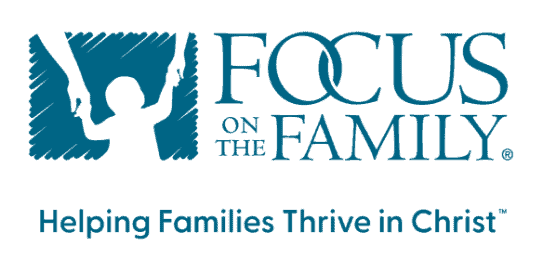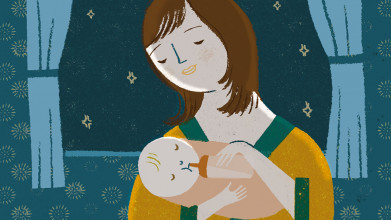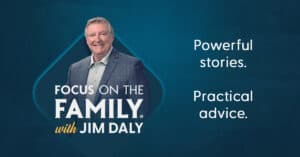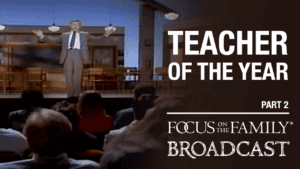Preview:
Heather Avis: And we have opportunities all around us to step into spaces with people who are different than us in an intentional way. Is it gonna be messy? Of course. Is it gonna be hard? Yes. Is hard bad? No, not always.
End of Preview
John Fuller: Heather Avis knows the joy of having three adopted children, and two of them have Down syndrome. She’s here today on Focus on the Family with Jim Daly to shout the worth of every life made in the image of God. Thanks for joining us. I’m John Fuller.
Jim Daly: First, John, how encouraging to hear this message?
John: Mm-hmm.
Jim: What a great message about life. And it’s so interesting how we naturally gravitate toward those who are like us, look like us, think like us. And yes, it’s pretty comfortable to be in that kind of community, but we can also get into a box or a pattern in our relationships and miss learning about how other people think and what their perspective is. I know that Jesus did exactly that. I mean, He really did think differently than the Pharisees and the scribes, the religious leaders of the day. So much so that it created incredible conflict.
John: Mm-hmm.
Jim: A few years back, our guest, Heather Avis, uh, had a lot to share about this idea of broadening our horizons to love and accept others who tend to be marginalized in our society. And she helped us to see things a little differently as she shared her story. So we’re coming back to that great message.
John: It’s a really unique and uplifting story, and Heather has written about it in her book called Scoot Over and Make Room:–
Jim: (laughs).
John: … Creating a Space Where Everyone Belongs. Uh, you can get a copy of that when you call 800-232-6459, 800, the letter A, and the word FAMILY. Or stop by focusonthefamily.com/broadcast for the details. Here’s that conversation now with Heather Avis on Focus on the Family, with Jim Daly.
Jim: Heather, welcome back to Focus.
Heather: Hi. Thank you so much for having me.
Jim: It’s great to have you back. Um, you know, I just mentioned that idea of accepting and loving the marginalized. It’s something we talk about often here at Focus on the Family, our own foster adoption program, et cetera. Get engaged with foster care and wraparound care and all those wonderful things we can do to be engaged in culture. Uh, but give us the big picture of how God put this on your heart and what you wanted to accomplish by writing this great book, which I love the title by the way.
John: Hmm.
Heather: Thank you. Thanks. So, I, I, in a lot of the things I’ve done in my life, I have fallen into them and it’s been reactionary. It’s been God opening up doors and me stepping into them, which is my story with all three of my adoptions for my children, how my family came to be. And as my daughter got, my oldest daughter, her name is Macyn, and she’s 11, and she, she came home as an infant and she has Down syndrome. And as we stepped into spaces, as she got older, we stepped into dance classes, we stepped into churches, we stepped into schools. I just quickly realized that who she is is not fully accepted.
Jim: Yeah.
John: Mm-hmm.
Heather: Um, people don’t understand her. They’re, they don’t know her, so they can’t understand her. They’ve never been around someone with Down syndrome. And I’m living life with her and I’m seeing an image of God in her that I don’t see in anyone else because she’s uniquely who she is, bearing the image of God with Down syndrome.
John: Mm-hmm.
Heather: So over the years, it was, wait a second. This is such a gift to my life. My understanding of humanity, my understanding of God, my understanding of His love for humanity has changed so drastically because I get to live with my kids.
Jim: Yeah.
Heather: And then stepping out of our front door and knowing that their worth and value is not seen-
Jim: Yeah.
Heather: … as the second they step out my front door.
Jim: Heather, let me ask you a question that maybe some are, are asking, which should be for you and your husband, Josh, what would compel you to adopt someone who struggles like that? Um, you know, it wasn’t the normal box you checked.
Heather: Mm-hmm.
John: Mm-hmm.
Jim: I’m sure in the adoption process you must have been okay. ‘Cause they ask, you know, when you’re-
Heather: Mm-hmm.
Jim: … seeking adoption, they’ll ask you what, um, difficulties are you willing to live with? Jean and I have done that through foster care. There’s no normal box, everybody.
Heather: Mm-hmm.
Jim: Because these kids are usually emotionally traumatized in some way.
Heather: Mm-hmm.
Jim: And at least in the foster system, you get lots of, uh, you know, behavioral issues.
Heather: Mm-hmm.
Jim: But I think the question many would ask in our comfort and leisure culture-
Heather: Mm-hmm.
Jim: … why put yourself out?
John: Mm-hmm.
Jim: Why’d you do this, you and Josh?
Heather: Well, and not to simplify it ’cause it’s not simple at all, but it really was God. And that’s the short answer. But the long answer was we had said no to who she is on paper, we said no to Down syndrome. She also had a lot of health issues. We found out about later, um, that we s- had said no to all of these things. And there as we’re saying no, the opportunity continues to present itself. And so I say for us, it was one scary step in front of another. Some days lifting our foot up, not knowing where it would fall. And it was, we didn’t wanna say yes, but we couldn’t say no.
John: Mm-hmm.
Heather: And we were just continually stepping towards this idea of adopting a little girl with Down syndrome. And I had a moment for me that felt really holy, where I felt that God was giving me a vision of sorts, if you will, where He was presenting me with a beautiful wrapped package. And I unwrap it and I go, wait a second. This isn’t what I wanted. I didn’t ask for this. And trying to hand back to God the gift that He was giving me.
Jim: Yeah.
Heather: Um, and that moment really solidified for my husband and I to say, “Okay, yes, we’re gonna adopt this child.” And we say it was our scariest and our best yes.
John: Mm-hmm.
Heather: Stepping into saying yeah, to adopting her and bringing her into our home.
Jim: Yeah.
Heather: Um, but we were terrified for most of the time.
Jim: Well, which is normal.
Heather: Yeah.
Jim: Actually (laughs).
Heather: Yeah.
Jim: That’s a good thing.
Heather: And just even, even learning that, I think a lot of the things in life that ha- hold a lot of value are very scary things to say yes to.
Jim: Now to help the, the audience, give us kind of the, the birth order of what happened. You know, your adoptions, uh, when did Macyn come into your family?
Heather: Mm-hmm.
Jim: Just give us a picture of that.
Heather: Sure. So Macyn was three months old when we found out about her and she came home around four months.
Jim: She was number one?
Heather: She’s number one.
Jim: Okay.
Heather: She came home at four months old.
Jim: Okay.
Heather: We live in Southern California and all of our kids were born in Southern California. So she came home, she had a congenital heart defect that required open heart surgery, which happened a month after coming home. And then she had this lung condition called pulmonary hypertension and was on oxygen 24/7 and multiple medications. So those first few years with her, um, we just didn’t know, there were a lot of unknowns in terms of her health. It was pretty wild. And I tell people too, it was my first child, so it was my normal. I didn’t know any different.
Jim: Right.
Heather: And it all felt pretty normal to us, even though we knew it wasn’t.
Jim: Mm-hmm.
Heather: Um, and then she actually, it was, it’s been te- nine years since she was totally healed of her pulmonary hypertension. And for the last nine years, she’s had no medication, no oxygen.
Jim: Uh-huh.
Heather: So we say yes to her, and then we get this front row seat to miracles that we would’ve missed out on had we-
Jim: Huh.
Heather: … stayed comfortable in our, in our little comfortable bubble.
Jim: Amazing.
Heather: Yeah. It is amazing. And then we, our next adoption, because God had taught us so much with her, and we tried to have so much control with our first one. Our next one was, okay, God, whatever you want, we’ll take any child. And we got a phone call for a little girl who was five months old and no disabilities, no health issues, no drug exposure in utero, which is unheard of in the foster care system. Not unheard of, but rare. And we, so we were gonna say yes to any kid that came her way. So that’s our middle daughter, Truly Star. Um, she is Guatemalan African American. So my husband-
Jim: And her first name’s Truly?
Heather: Truly.
Jim: And then, uh, that’s number two. And then number three.
Heather: So number three, um, just as I’m in a season of life where my two kids are consuming all of me, and I think I can’t do one more thing (laughs).
Jim: (laughs). Okay. This is normal parenting so far.
Heather: Yes. Yes. Um, we got a phone call about a woman who was seven months pregnant and got an in-utero diagnosis for Down syndrome, and he had a congenital heart defect. Um, and so that happened in October and in December he was born and came home, August, our son. So we got to go to the hospital the day he was born, and he came home at two days old.
Jim: And August is doing better?
Heather: He’s great. So he had open heart surgery at four months old and is just totally healthy.
Jim: Okay. So you’re, you’re in this situation, I mean, you’ve not been a birth mom.
Heather: Mm-hmm.
Jim: And you adopt Macyn, and then Truly, and then you adopt August.
Heather: Mm-hmm.
Jim: And did you… you got into some of this comparison game-
Heather: Mm-hmm.
Jim: … which is normal for parents. We used to do that because Trent is such a tall kid. But I mean, in that context for you, how did it affect you that comparison game that so many parents play?
Heather: Yeah. Um, there’s the saying, I think it was Theodore Roosevelt, that comparison is the thief of all joy.
Jim: Uh-huh.
Heather: And so I found that happening in my life just as a mom. Like you said, with parenting, you’re just thrust into it. And even the book, there’s books like What to Expect When You’re Expecting.
Jim: Right.
Heather: And it’s literally a chart of what your child should be doing. And then-
Jim: So this is normal.
Heather: This is normal. Right.
Jim: Right.
Heather: This is what your kid should be doing. And so, and then if your kid’s exceeding that, then it’s like, well, look how great my kid is-
Jim: Right. Right.
Heather: … compared to your kid. And so it just creates a lot of unhealth, I think. And then when you have a child with Down syndrome, they’re not gonna fit-
Jim: Right.
Heather: … into those molds. Um, they’re not gonna land on the chart. And so then you start, I found myself with my oldest, Macyn, like I had to put the books away and stop comparing her to her neurotypical peers. But then you’re put in this Down syndrome world, and then it’s like, well, wait a second. This kid’s walking and has Down syndrome. And then the comparison, I felt it was magnified in that space. Um, that it was-
Jim: Hmm.
Heather: … my kid with Down syndrome isn’t doing these things, but this kid with Down syndrome is.
Jim: Right.
Heather: How do I fix my kid? How do I make my kid more like this kid?
John: Hmm.
Jim: What, what did you think in the end? I mean, what did the Lord teach you about that specifically? Because again, we can have healthy children, we still do the comparison game. So I’m just curious, how did God calm your heart and what did He speak to you-
Heather: Mm-hmm
Jim: … in terms of that comparison game?
Heather: Yeah. I feel like I still fall into it, right? It’s a trap that we-
Jim: Right. We’re all human.
John: Yeah.
Jim: Yeah. Sure.
Heather: … just fa- fall into. But the thing that God’s really shown me, um, especially with my oldest daughter, Macyn, is that every person is so uniquely made in God’s image and for God’s purposes. And to just fully embrace who my kids are and appreciate who they are. Um, it’s just been a lesson that I continually need to learn. And really that recognizing that when I compare my child to another child, it is stealing the joy of who my kid is.
John: Mm-hmm. Yeah.
Heather: And so if I wanna take away all of the noise around me and all the comparison that’s happening that, or all the comparison I could do, and look at my daughter Macyn and say, “She’s amazing. And she’s amazing exactly h- as she is.” Not, if she walks earlier, not if she’s able to read at a higher level, not if she’s able to run as fast as another kid, like who she is, is incredible.
Jim: Yeah.
John: Hmm.
Heather: And so just checking myself, you know, my, and having people in my life like my husband who can, we can do that with each other. Like, I get, I’ll go down these rabbit trails of what Macyn needs to be doing, dah, dah, dah, dah, dah, whatever, A, B, C, D. She’s not doing this. This kid is, she needs to. And then stop being like, “Wait a second. She’s a miracle. She’s incredible. What a gift a- exactly as she is.” And being able to do that with each of my kids, like exactly as they are, they’re such a gift because God created them to be who they are.
Jim: Mm-hmm.
Heather: And what an honor to get to witness that.
Jim: Absolutely.
John: Yeah. Heather, you said something and I’m, I’m just curious about this. I think this applies to parents of neurotypical kids, as you said, or any child with special needs. Um, we want to advocate and we have to sometimes advocate for, better for them.
Heather: Mm-hmm.
John: Where’s, where’s the, the line or perhaps the gray area for you in that between accepting and also just saying, well, if we do this, this actually could help the child.
Heather: Mm-hmm.
John: Achieve something that if we pull back and just say they are who they are.
Heather: Mm-hmm.
John: You, you hear what I’m saying on that?
Heather: Oh, absolutely. And I think that’s the thing that one of the trickiest parts of parenthood is constantly checking yourself. Right? Am I doing this? I, I want my child to be the best version of themselves.
John: Yeah.
Heather: So that’s also the conversation.
John: So a lot of, a lot of it’s motive-
Heather: Yeah.
John: … for why you’re doing that too.
Heather: Right. And I’m gonna push Macyn, and all of my kids, to be the best version of themselves.
John: Yeah.
Heather: Not the best version of my friend’s kid.
John: Uh-huh.
Heather: It… So it’s that difference.
Jim: That’s a huge difference.
Heather: Mm-hmm.
Jim: But I love that approach because it helps the child to have their own identity, their own self-worth.
John: Mm-hmm.
Heather: Mm-hmm.
Jim: That they too don’t have to compare, right?
Heather: Right. Yeah. Hopefully.
John: Uh, we’re talking to Heather Avis today on Focus on the Family with your host Jim Daly. And you can get Heather’s book and, uh, that previous conversation we had with her that I mentioned earlier. Uh, the book is called Scoot Over and Make Some Room:, uh-
Jim: Mm-hmm.
John: … Creating a Space Where Everyone Belongs. Uh, stop by, focusonthefamily.com/broadcast to find it.
Jim: You know, Heather, uh, sadly so many people in the culture have really marginalized, um, this population with Down syndrome. In fact, I, I know on the news, uh, you know, a while back, I think it was Iceland claimed-
Heather: Mm-hmm.
Jim: … that they had eradicated Down syndrome by basically aborting all children that were diagnosed in utero-
John: Mm-hmm.
Heather: Yeah.
Jim: … with Down syndrome. And, uh, you know, others come along and they say, certain things, I’m sure about your kids. Uh, I really wanna learn, I want the listeners to learn so we can communicate better in this space. What are those things that are, um, a little more hurtful and maybe some things that are helpful the way people communicate around you?
Heather: Yeah. I don’t even know, as I’ve gone on this journey, it’s not even specific phrases or specific incidents. It really is a posture of the heart that is really the message I want to get out into the world. And the posture that I want people to approach my children with is that they see them, they see that they have Down syndrome, and they see it as an asset. And we live in a world still that sees Down syndrome as a deficit or sees a disability as a deficit or sees some significant difference-
Jim: Sure.
Heather: … as a deficit. And to approach my children with, “Wow, they’ve got Down syndrome, that makes them different.” And even say, “And I’m uncomfortable with that, but I’m willing to lean into that because I know that they have something to offer the world and to offer myself because, that is good, um, because the fact that they have Down syndrome is an asset.”
Jim: Okay.
Heather: So it’s more that posture.
Jim: Yeah. Which I like. But what are some of those things that people have said that have been harmful or hurtful that they don’t even, you know, maybe not even realizing that they’re piercing you?
Heather: Sure. Um, people, I mean, people will say things, and again, it’s looking at their deficit. Like, “Oh, you know, you know, they’re gonna be with you forever,” but not in a positive way. You know?
Jim: Right. They’re-
Heather: Like they’ll never, they’ll never have independence.
John: They’re gonna be an anchor on your lifestyle.
Jim: Right.
Heather: Yeah. Yeah. And-
Jim: As if you haven’t thought that through.
Heather: Right.
Jim: (laughs).
Heather: Right.
Jim: Right. They want to be a revelation-
John: Yeah.
Jim: … of knowledge to you (laughs).
Heather: Yeah. Or, um, things that are harmful is to blanket an entire population of people. So a blanket statement. So, oh, people with Down syndrome are so loving and love, love to hug and joke. I’m like, “Well, actually, Macyn doesn’t prefer hugs. And she can be really bratty.”
Jim: Huh.
Heather: And people with Down syndrome actually have a full range of emotions, just like you and me.
John: Mm-hmm.
Jim: Yeah.
Heather: So those kinds of comments and ideas are, are really harmful. Um-
Jim: So the stereotyping kind of thing.
Heather: The stereotyping, yeah.
Jim: Yeah.
John: Mm-hmm.
Jim: Heather, one of the, even as we’re describing everything we’re talking about, I think one of the, one of the key things is for people who are not around this, you know, they don’t have a family member in this place-
Heather: Mm-hmm.
Jim: … it’s uncomfortable.
Heather: Mm-hmm.
Jim: ‘Cause we don’t wanna offend. So we kind of pull back, you know, you don’t engage, you don’t lean forward, as you said a moment ago.
Heather: Mm-hmm.
Jim: And I really wanna hear from you what expectations are there, because I think we’re so afraid to mess up.
Heather: Mm-hmm.
Jim: That we don’t wanna risk it, so we just clam up.
Heather: Mm-hmm.
John: Mm-hmm.
Jim: If I could say it that way.
Heather: Yeah.
Jim: And John, you probably experienced this too, you and Dena, um, but, i- i- what would you say to us able-bodied people with able body children and we’re engaged at church, and there you show up.
Heather: Mm-hmm.
Jim: How do you… what do you expect from us?
Heather: Oh, gosh, that’s a big one (laughs).
Jim: It is. But I think it’s-
Heather: But, yeah. It’s great.
Jim: … it’s a critical one.
Heather: It is.
Jim: Because we don’t, we don’t know. So we pull back.
Heather: Mm-hmm.
Jim: And then you feel like I’m alone here even though I’m in this big church, maybe.
Heather: Right. And there’s a few different pieces to this. I think the first is to recognize how important proximity is. And inclusion’s important because it offers proximity to someone who is different than you, which then leads to relationship, which then leads to the change that we need to see happen. So the younger you start, the better. Like anyone listening who has little kids, the sooner you can get your child exposed or within proximity to people who are different, the better they’re of they’re gonna be. Because, you know, if, if you have kids, kids are so honest and sweet and innocent in their question asking and-
Jim: And accepting mostly.
Heather: … and accepting, and accepting.
John: Yeah.
Heather: And the more exposure they have, then the more accepting they’re gonna be as they get older.
Jim: Mm-hmm.
Heather: Granted if… or compared to like a fifth grader, when a fifth grader meets someone for the first time ever who has a disability, that’s shocking to them. Whereas if they grew up with someone with a disability, then it’s great, you know, it’s easier to accept.
Jim: Yeah.
Heather: So I think starting real young.
Jim: That’s good.
Heather: And then any great growth that’s gonna happen in our lives is gonna come from risk, from taking a risk. So when you see the person with a disability and your child’s asking awkward questions, or you have questions or you’re feeling uncomfortable, then you do have the two choices you can back off and not have any opportunities for learning and growth in that experience. Or you can lean in and step closer and be in proximity and ask the questions. And you might offend someone. And that’s the risk you’re taking. You know, you might feel silly in the way that you approach them. You might feel uncomfortable, but if you don’t take that risk, then you don’t get to learn and grow-
Jim: Yeah.
Heather: … as a human being. And you don’t to… get to create a more inclusive world, which is God’s heart. Right? If you look at-
Jim: Yeah. I mean, it’s such a great lesson in that way.
Heather: Yeah. Creation. You look at humanity, God is, God is a God of inclusion.
John: Mm-hmm.
Jim: All right. I have not met Macyn yet.
Heather: (laughs).
Jim: But when I do, (laughs) I understand she likes hip hop music, which-
Heather: Yeah.
Jim: … I’m really gonna take her to task for.
Heather: (laughs).
Jim: But what’s this thing about hip hop and then she does dance lessons with this?
Heather: Yeah. Yeah.
Jim: So describe that.
Heather: Uh, Macyn loves hip hop. Macyn loves to dance.
Jim: (laughs).
Heather: So we sit, she started dancing before she started walking. Um, she would, she scooted on her tush. She didn’t crawl. She was a scooter. And if music came on, she would just stop in her tracks and start swaying side to side. She didn’t start walking until almost three years old. So she was-
Jim: That’s really cute actually.
Heather: … a little dancer. Yeah.
Jim: Yeah.
Heather: And we put her in a hip hop class and hip hop’s her favorite, um, genre.
Jim: That’s so fun.
Heather: I think there’s more freedom in hip hop.
Jim: Yeah.
Heather: A lot of dance.
Jim: A lot of movement.
Heather: Is very technical.
Jim: A lot of rhythm.
Heather: Yeah.
John: Yeah.
Heather: And hip hop has technique to it.
John: Yeah.
Heather: But less so than ballet, you know?
Jim: Right.
Heather: Ballet’s a little slow. We tried ballet and she’s like-
Jim: (laughs).
John: (laughs).
Heather: … “Nah, this is, this isn’t what I want.”
Jim: Well, I would agree with her there too.
John: Yeah.
Heather: (laughs). Yeah. Yeah. And ballet’s great. It’s just not her thing. And we put her in a hip hop class when she was eight. And the way that I approach things with my kids when we enter into spaces is we show up with an expectation that my child will be welcomed there. So I’m not asking anyone permission for my children to be in any space. And that’s what I did. I said, “Hey, my kid has Down syndrome. Do you have questions? You know, are there any questions anyways I can help here.” And the teacher said, “No, that’s fine. She can join the class.” And so then Macyn started hip hop and the only kid with Down syndrome or any disability in her class, and she loved it.
Um, and every week she was so excited to go. And what we witnessed happened, it’s a very long story, but we, through relationship, through that proximity, um, building a relationship with the dance studio owner and the relationship she built with her peers in the class who had no exposure ever to someone with Down syndrome before this, we saw hearts and lives literally change for the better because of the ways in which they embraced Macyn, because Macyn didn’t show up dancing like everybody else. She was very different in the way that she danced also.
Jim: Right.
Heather: And when it came time for the recital, everybody had to adjust, right? Everyone had to scoot over and make room for Macyn to be fully included and accepted and honored as a dancer in this program. And it’s the first time they’ve had to do that, and they did it.
Jim: Mm-hmm.
Heather: They did it. And it was holy. It was one of, one of the holiest moments of my life. And I’m still very young, so I have many moments to come (laughs). But I’ve, even in adopting the children that we have, and all the amazing things God has done was watching my daughter dance in the recital-
John: Hmm.
Heather: … in the ways that, and who would, who would’ve thought at a dance studio, right?
John: Yeah.
Heather: In the ways that hundreds of people were bending and flexing and making space for her to fully show up as she was. It was, it was holy. It was amazing.
Jim: And I like, and I wanna remind the listeners, uh, I like what you’re saying there about what she’s able to teach those of us-
John: Mm-hmm.
Heather: Mm-hmm.
Jim: … who think we’re normal (laughs).
Heather: Mm-hmm. Right.
Jim: And, you know, the idea of bending and adjusting and seeing things, she’s still made in the image of God.
Heather: Exactly. Exactly.
Jim: Um, even though she may not fit that mold, right?
Heather: Right.
Jim: And that’s beautiful.
John: Describe, describe the holiness that you saw. ‘Cause I, I’m thinking of a recital at a school-
Heather: Sure.
John: … or a studio, and I’m not catching the holy part of it.
Heather: Yeah-
John: Quite as much as you have.
Heather: I- it’s a longer more detail, so I’ll go there. Um, it was really more at the dress rehearsal. And so at the dress rehearsal when the kids went out to dance, she didn’t, um, she really panicked a little bit and everything was new and it was, the lights were brighter and the music was louder than she thought, and she didn’t know what to expect. And so she really panicked and shut down. And as I’m ready to leave, we decide to go in and watch the dancers. And Macyn just turns to me and she says, “All right, mom, I’m ready.”
Jim: (laughs).
Heather: And so where five or six routines pass, maybe even more. And we walk backstage and she taps her teacher and says, “I’m ready to dance.” And without stopping or skipping a beat, her teacher says, “All right, we’re gonna pull up the lights and the music for Uptown Funk.” That was the song she danced to. “And we’re going to, we need to find as many dancers as we can who are in this routine. Can you go find them?” And everyone in her dance class, except for her, were in 2 to 10 routines. They were-
Jim: Yeah.
Heather: … like hardcore dancers. And so it happened to be that everybody who was in her hip hop class was on deck for their ballet routine. And so they’re all standing there hearing all this, and they’re wearing, um, like these big cream-colored tutus-
Jim: (laughs). Right.
Heather: … and these full length gloves and a velvet, like this velvet vest and their ballet shoes and Macyn’s there, and their hip hop outfit, which was like a red crop top and drop-crotch harem pants.
Jim: (laughs).
Heather: And they, they’re like, “What? We already did that. We have to, we’re gonna dance in this?” And the instructor turns around and says, “Um, nobody has to do this, but you’re a team, so I expect you to, and you absolutely can dance in that costume.”
Jim: Yeah.
Heather: Then one little girl raises her hand and says, “I wanna dance with Macyn.” And they all chime in. And so then what proceeds was the holy moment of they walk out on stage and the instructor says to me, “You get out in the audience and you, you watch your girl dance.” And it was, I look at the stage and it was, oh my gosh, here are a dozen or so girls who are in these cream tutus and these full length gloves and Macyn in her crop, red crop top dancing to Uptown Funk, 10 songs too late. And it was this hundreds of people ’cause of everyone that it affected after bending and flexing and making space for Macyn and honoring her.
Jim: Yeah.
Heather: Um, it was the vision of the kingdom. It was inclusive minded, and she didn’t need to be just like everybody else. She just needed to be fully who she was.
Jim: Yeah. Great story.
Heather: Yeah.
Jim: And how that impacts your everyday life.
John: Hmm.
Heather: Yeah.
Jim: Let me talk about Truly, you mentioned Truly-
Heather: Mm-hmm.
Jim: … a little while ago, and I do wanna come back to that. Your middle child, she, uh, as you said is African American. Um, you adopted her, uh, and of course you and your husband are both Caucasian.
Heather: Mm-hmm.
Jim: Um, have you navigated some of those issues of race with, with your daughter? And what are some of those interesting moments that pop up, like, you know, we’re different colors?
Heather: Right. Um, have navigated as best I can and continue to navigate it. It’s so hard.
Jim: What does some of those things look like? For those of us that, that don’t live in that world every day. You know, we don’t… haven’t adopted a minority child or-
Heather: Right.
Jim: Yeah. What does that look like?
Heather: Um, I mean, she’s very aware that she’s the only person in our home with brown skin and curly hair. And so she asks about it a lot. “Um, why do I have brown skin? Why, why would you choose to have someone with brown skin?”
Jim: Mm-hmm.
Heather: Um, she’s eight years old now. And… or things like the culture is telling her, culture is telling all of our children that there’s a certain best way to be. And it’s often not being a little brown girl with, with curly hair. And so she’s up against that in terms of society. But then I’m also a white mom, so she’s not seeing herself in her family. And I don’t know what that’s gonna look like in her future, but what it looks like for us is being incredibly intentional to be in spaces where she sees people who look like her so that she feels comfortable with who she is and confident in who God’s made her to be.
Jim: Yeah. Which I think would be your greatest challenge. You and your husband, Josh.
Heather: Mm-hmm.
Jim: How do we encourage Truly to, to feel confident in who she is?
Heather: Yeah.
Jim: I mean, regardless of the color of a child’s skin, all of us parents have that challenge-
Heather: Yeah.
Jim: … with our children to make them know their identity in Christ and make sure that they are as firmly planted as possible.
Heather: Definitely.
Jim: So that when the winds of life, however that might come from teasing or bullying at a young age-
Heather: Mm-hmm.
Jim: … uh, that they can weather that. Um, how… what are some practical things that you’ve done to help Truly?
Heather: Right. And with Truly, because she is spending a lot of her time around people who don’t look like her because she is a minority in her family, um, we are very intentional. Most of our books, the main characters are people of color. We have very few books that have the main character, or every person in the book is white.
Jim: Mm-hmm.
Heather: Very, very few. Her toys, um, her dolls all, or all the kids’ dolls have always been not white.
Jim: Mm-hmm.
Heather: The shows that we watch. And then we are just intentional where she goes to school. We have her at a school right now that, um, most of the kids look like her. And it’s a different school than our other two. And so we, we’ve chosen to be at a church with people who look different.
John: Hmm.
Heather: Um, it’s been, it’s required us to be very intentional.
Jim: Yeah. And I love it. I think that is really smart parenting, really.
Heather: Yeah.
Jim: When you, you look at it. Let me ask you, Heather, uh, we’re down on, you know, the last minute here. So what’s that challenge you would give, uh, all of us in our personal interactions in order to discover God’s best for our lives? How about that for a question?
Heather: That’s a good one.
Jim: (laughs).
Heather: Um-
Jim: And you’re living it.
Heather: Right.
Jim: That’s what makes it so palpable coming from you. I mean, you and your husband, Josh, you didn’t take the easy way.
Heather: Mm-hmm.
Jim: And most people are still going. “Well, Heather’s an angel obviously.
Heather: No.
Jim: So I could never do that.” No, I’m serious though.
Heather: Sure.
Jim: People are gonna ascribe a lot of things to you and your husband-
Heather: Sure.
Jim: … that you can do this and we can’t. But you’re going, “No, that’s not true. Everybody can do this if they choose to.”
Heather: If they choose to.
Jim: So what would be that advice to us? To broaden our perspectives, to not live in a cocoon.
Heather: Mm-hmm.
Jim: And you can fill out the rest.
Heather: Sure. So, and just to clarify, my husband and I are average at best.
Jim: (laughs).
John: (laughs).
Heather: So we’re very average humans. Um, the truth is God is more diverse than we could ever wrap our minds around. And we know that God’s created all human beings in the image of God. And every human being is an image bearer of God. And so we have an opportunity to know God more fully, to have a better appreciation of what it means to be human in the fullness of humanity only if we intentionally step into spaces with all the different kinds of humans.
Jim: Mm-hmm. Yeah.
Heather: Um, if we’re going to choose to stay in a space that is very much safe and like us, or where we’re around people who are like us in a very homogeneous space, then we’re gonna miss out on the fullness of God.
Jim: Mm-hmm.
Heather: And that’s just the truth. That’s just the truth. And we have opportunities all around us to step into spaces with people who are different than us in an intentional way. Is it gonna be messy? Of course. Is it gonna be hard? Yes. Is hard bad? No, not always.
Jim: Mm-hmm.
Heather: And so it’s willing to take those steps into the hard spaces, the messy spaces where that’s where Jesus is hanging out, where you’re really gonna get to know God in all of His goodness.
Jim: (laughs).
John: Mm-hmm.
Jim: That is… those are words of wisdom I’ll say.
Heather: (laughs).
John: Well-said, yeah.
Jim: Heather, this has been so good. Thank you for being back with us. Thank you for your great book, Scoot Over and Make Some Room. Again, I love the title.
Heather: (laughs).
Jim: It’s so good. And, uh, you know, for a gift of any amount, we’ll send you a copy of Heather’s book as our way of saying thank you. If you can do that through a, a monthly support, that’s great. ‘Cause it helps us to even out the, uh, the budget for the year.
John: Mm-hmm.
Jim: … But if it’s a one-time gift, we’ll do the same. If you can’t afford it, uh, just get in touch with us. Uh, we’ll trust that others will compensate and, uh, make up enough ground that we can give you that book as a love gift from us. So thank you again, Heather, and, uh, I hope if you know somebody, uh, that needs this resource, get ahold of us.
John: Mm-hmm. Yeah. We have the book here at the website and when you’re online with us, we’ll give you free access to the Special Needs Parenting Audio Collection which features about four hours of content. You’ll be encouraged and inspired by other parents of children with special needs as they share their stories. So donate today and request the book and the free audio collection at focusonthefamily.com/broadcast or call for details. 800, the letter A, and the word FAMILY, 800-232-6459. On behalf of the entire team, thanks for joining us today for Focus on the Family with Jim Daly. I’m John Fuller, inviting you back as we once again help you and your family thrive in Christ.

















